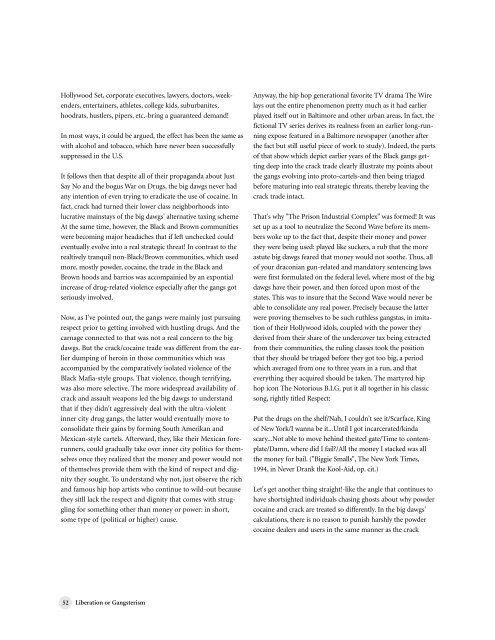MXGM Self-Defence Manual
MXGM Self-Defence Manual
MXGM Self-Defence Manual
Create successful ePaper yourself
Turn your PDF publications into a flip-book with our unique Google optimized e-Paper software.
Hollywood Set, corporate executives, lawyers, doctors, weekenders,<br />
entertainers, athletes, college kids, suburbanites,<br />
hoodrats, hustlers, pipers, etc.-bring a guaranteed demand!<br />
In most ways, it could be argued, the effect has been the same as<br />
with alcohol and tobacco, which have never been successfully<br />
suppressed in the U.S.<br />
It follows then that despite all of their propaganda about Just<br />
Say No and the bogus War on Drugs, the big dawgs never had<br />
any intention of even trying to eradicate the use of cocaine. In<br />
fact, crack had turned their lower class neighborhoods into<br />
lucrative mainstays of the big dawgs' alternative taxing scheme<br />
At the same time, however, the Black and Brown communities<br />
were becoming major headaches that if left unchecked could<br />
eventually evolve into a real strategic threat! In contrast to the<br />
realtively tranquil non-Black/Brown communities, which used<br />
more, mostly powder, cocaine, the trade in the Black and<br />
Brown hoods and barrios was accompainied by an expontial<br />
increase of drug-related violence especially after the gangs got<br />
seriously involved.<br />
Now, as I've pointed out, the gangs were mainly just pursuing<br />
respect prior to getting involved with hustling drugs. And the<br />
carnage connected to that was not a real concern to the big<br />
dawgs. But the crack/cocaine trade was different from the earlier<br />
dumping of heroin in those communities which was<br />
accompanied by the comparatively isolated violence of the<br />
Black Mafia-style groups. That violence, though terrifying,<br />
was also more selective. The more widespread availability of<br />
crack and assault weapons led the big dawgs to understand<br />
that if they didn't aggressively deal with the ultra-violent<br />
inner city drug gangs, the latter would eventually move to<br />
consolidate their gains by forming South Amerikan and<br />
Mexican-style cartels. Afterward, they, like their Mexican forerunners,<br />
could gradually take over inner city politics for themselves<br />
once they realized that the money and power would not<br />
of themselves provide them with the kind of respect and dignity<br />
they sought. To understand why not, just observe the rich<br />
and famous hip hop artists who continue to wild-out because<br />
they sitll lack the respect and dignity that comes with struggling<br />
for something other than money or power: in short,<br />
some type of (political or higher) cause.<br />
Anyway, the hip hop generational favorite TV drama The Wire<br />
lays out the entire phenomenon pretty much as it had earlier<br />
played itself out in Baltimore and other urban areas. In fact, the<br />
fictional TV series derives its realness from an earlier long-running<br />
expose featured in a Baltimore newspaper (another after<br />
the fact but still useful piece of work to study). Indeed, the parts<br />
of that show which depict earlier years of the Black gangs getting<br />
deep into the crack trade clearly illustrate my points about<br />
the gangs evolving into proto-cartels-and then being triaged<br />
before maturing into real strategic threats, thereby leaving the<br />
crack trade intact.<br />
That's why "The Prison Industrial Complex" was formed! It was<br />
set up as a tool to neutralize the Second Wave before its members<br />
woke up to the fact that, despite their money and power<br />
they were being used: played like suckers, a rub that the more<br />
astute big dawgs feared that money would not soothe. Thus, all<br />
of your draconian gun-related and mandatory sentencing laws<br />
were first formulated on the federal level, where most of the big<br />
dawgs have their power, and then forced upon most of the<br />
states. This was to insure that the Second Wave would never be<br />
able to consolidate any real power. Precisely because the latter<br />
were proving themselves to be such ruthless gangstas, in imitation<br />
of their Hollywood idols, coupled with the power they<br />
derived from their share of the undercover tax being extracted<br />
from their communities, the ruling classes took the position<br />
that they should be triaged before they got too big, a period<br />
which averaged from one to three years in a run, and that<br />
everything they acquired should be taken. The martyred hip<br />
hop icon The Notorious B.I.G. put it all together in his classic<br />
song, rightly titled Respect:<br />
Put the drugs on the shelf/Nah, I couldn't see it/Scarface, King<br />
of New York/I wanna be it...Until I got incarcerated/kinda<br />
scary...Not able to move hehind thesteel gate/Time to contemplate/Damn,<br />
where did I fail/All the money I stacked was all<br />
the money for bail. ("Biggie Smalls", The New York Times,<br />
1994, in Never Drank the Kool-Aid, op. cit.)<br />
Let's get another thing straight!-like the angle that continues to<br />
have shortsighted individuals chasing ghosts about why powder<br />
cocaine and crack are treated so differently. In the big dawgs'<br />
calculations, there is no reason to punish harshly the powder<br />
cocaine dealers and users in the same manner as the crack<br />
52<br />
Liberation or Gangsterism


